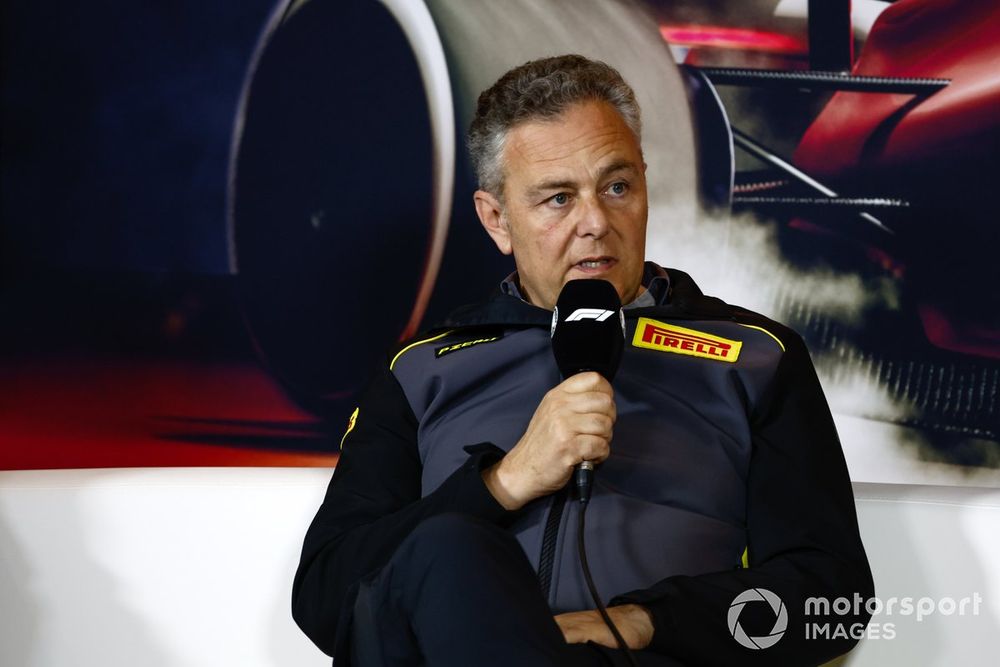
Pirelli says it has cleared up matters with Mercedes driver George Russell after his criticisms of “infuriating” performance fluctuations between its different tyres.
Russell spoke out after the Azerbaijan Grand Prix in saying that Pirelli’s current products were not “good enough” because of the wild swings in pace.
Having endured a race in Baku where he had struggled on the medium compound but then proved really strong on the hard as he grabbed a podium, Russell told the official F1 channel: “Honestly, it is actually pretty infuriating that it changes this much.
“It’s not just the Mercedes, it’s every team and every driver. One session, you’re fast, the next you’re not. And there’s only one thing that changes.
“It’s black magic. I think even the people who make the tyres don’t understand the tyres.
“I think we all need probably serious conversations again about what’s going on, because we’ve got 2,000 people working their butts off to deliver the fastest car.
“Twenty laps of the race, we had a car that was comfortable of fighting for victory, the twenty other laps we had a car that probably shouldn’t have been in the points – and the only difference is the tyres and it’s not good enough, really.”
In the wake of those remarks, Pirelli’s head of F1 and car racing Mario Isola sat down with Russell in Singapore to run through things – and explain why things had played out the way they did.

Speaking exclusively to Autosport, Isola said: “I spoke with George and we had a nice chat together, because obviously I understand that in the heat of the post-race interviews, with the adrenaline that was still very high, he said something to the media.
“On top of that, we also did some investigation, as we usually do after every race, to understand the behaviour of the tyres.”
Baku answers
Having conducted some analysis of what happened in the Azerbaijan GP, Isola said there were a host of factors at play that contributed to the way Russell was so much better on the hard.
“It is true that the pace of George on the medium was not great, while on the hard he was much quicker,” added Isola.
“But we know that the pace is a combination of elements. The set-up of the car is really important, the track evolution is really important, and the way in which the driver is treating the tyre in the first couple of laps, that's another very important element that in Baku was clearly visible.
“If you look at the last stint on the hard compound, we had some drivers that were obliged to push, like [Charles] Leclerc, for example, because he was following and he was stressing the hard compound. In the last few laps, he was not able to keep the pace of Oscar [Piastri] that was leading.
“George was running the first couple of laps saving the hard compound, not pushing too much, and he was much, much faster at the end. That was not the case on the medium.

“To be honest, if I look at the majority of the cars, we didn't find anything strange looking in the compound behaviour. We made a comparison of the level of degradation of McLaren, Red Bull, Ferrari, the top teams, and they are very, very close. Comparable.
“The delta lap time was confirmed, the behaviour of the compounds, both the medium and the hard, was confirmed. So, I cannot find anything strange. I believe that the two compounds that were used in Baku were working as expected.”
Tyre characteristics
Isola said that it was normal for car performances to not be identical on different compounds, and that the driver feel would also be totally different.
“If we talk about the hard and the medium in general, you have a hard compound that is more forgiving,” he added.
“If you stress the tyre more, the tyre is, in any case, more consistent. That means if you overheat the tyre, this effect is less visible because the compound has a higher working range, so you can push more.
“On the medium or the soft, clearly you increase this [overheating] effect quite a lot, and depending on the circuit, this delta effect can be much wider.
“It is also true that in a championship where we have at least four teams that are very, very close, every thousandth of a second counts in a race, and any difference is more visible.
“So, the reason why sometimes you have these different performances between one compound and the other is if you set-up the car in an optimal way for one compound, the risk is that you don't have the same result on the other. You stress the tyre more, you overheat it more, you accelerate the degradation, and you generate the graining.”







